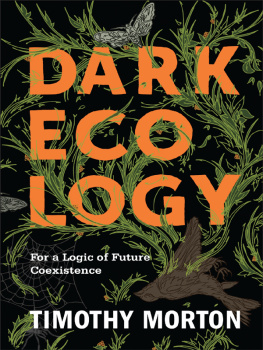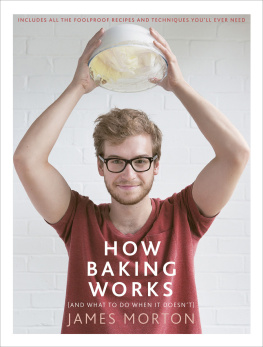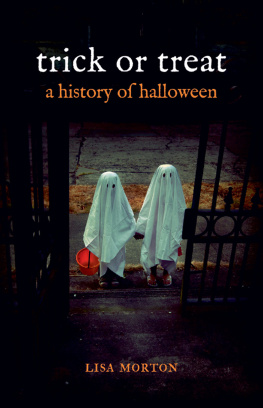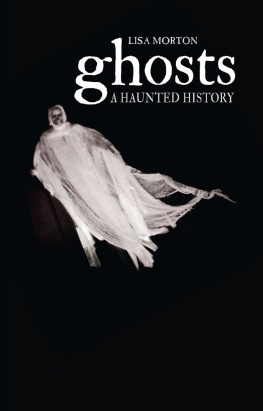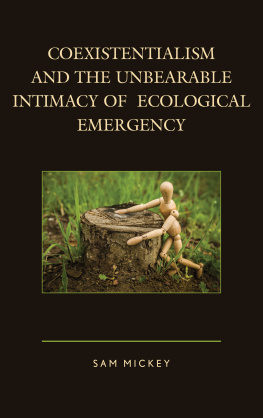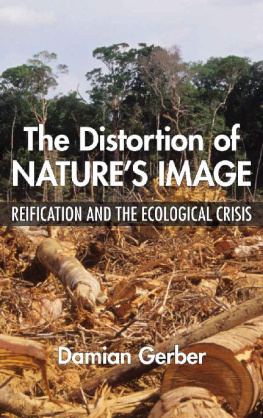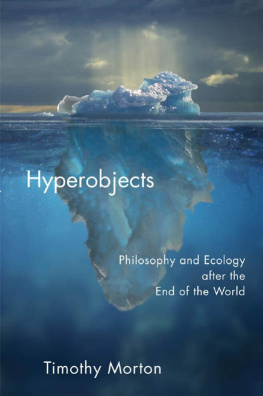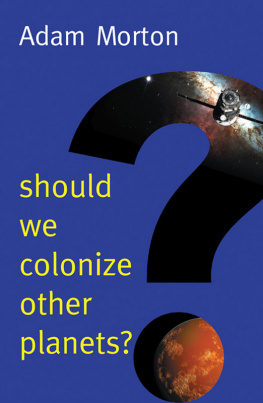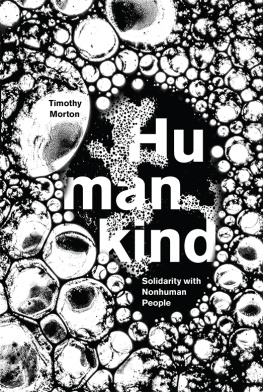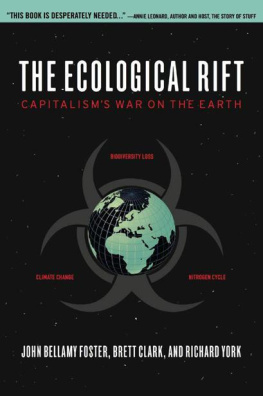DARK ECOLOGY
THE WELLEK LIBRARY LECTURES IN CRITICAL THEORY
The Wellek Library Lectures in Critical Theory are given annually at the University of California, Irvine, under the auspices of the Critical Theory Institute. The following lectures were given in May 2014
THE CRITICAL THEORY INSTITUTE
Gabriele Schwab, Director
DARK ECOLOGY
For a Logic of Future Coexistence
TIMOTHY MORTON
Columbia University Press
New York
Columbia University Press
Publishers Since 1893
New York Chichester, West Sussex
cup.columbia.edu
Copyright 2016 Columbia University Press
All rights reserved
E-ISBN 978-0-231-54136-7
Library of Congress Cataloging-in-Publication Data
Names: Morton, Timothy, 1968 author.
Title: Dark ecology: for a logic of future coexistence / Timothy Morton.
Description: New York : Columbia University Press, 2016. |
Series: Wellek Library lectures in critical theory | Includes bibliographical references and index
Identifiers: LCCN 2015026796 | ISBN 9780231177528 (cloth : alk. paper) |
ISBN 9780231541367 (e-book)
Subjects: LCSH: NatureEffect of human beings onPhilosophy. | Human beingsEffect of environment onPhilosophy. | Human ecologyPhilosophy. | Naturalness (Environmental sciences)
Classification: LCC GF75.M685 2016 | DDC.2dc23
LC record available at http://lccn.loc.gov/2015026796
A Columbia University Press E-book.
CUP would be pleased to hear about your reading experience with this e-book at cup-ebook@columbia.edu.
Cover design by Julia Kushnirsky
Cover illustration by Hannah Stouffer
References to websites (URLs) were accurate at the time of writing. Neither the author nor Columbia University Press is responsible for URLs that may have expired or changed since the manuscript was prepared.
For Allan
It was surprising how pure the sense of loss wasin a sense its because nonhumans dont have the same mediation with humans. I mean, you know your grandma or whoever is sick and that there is a hospital, there is a timeline of some kind. That and the fact that the outside (I should know this by now) is actually the (human) inside, so its strangely like losing a child to war. Its a war zone against nonhumans.
He was hit by the mail truck, the new delivery person having a habit of driving up the driveway. The worst aspect was that he tried to crawl back in with a smashed neck and head, so I found him right outside the cat door, still warm yet with rigor mortis. We buried him like an Egyptian with his favorite things and did a Buddhist death ritual right away. For the next few days we were totally rigid with depression, which slowly liquefied.
He wasnt murderedthough for a moment the obvious blunt force trauma to his neck looked very like it. One of my friends had a cat who was indeed killed by some psychopath who showed her the cats body in his freezer. Nevertheless Allan Whiskersworth was killed by humans in a friendly fire collateral damage sort of way. Cats weirdly symbolize the ambiguous border between agricultural logistics and its (impossible to demarcate) outside. I mean we dont let dogs just wander about. Its as if we want to use cats to prove to ourselves that there is a Nature. Allan was very happy bristling among the grasses and talking to his friend, the gray cat. He lived a Neil Young sort of life (burning out) and died at only two years old. Ive always liked Lennons response that hed much rather fade away (and look what happened to him).
Right after his death the Charon-like gray cat came to visit, never before or since.
Progress means: humanity emerges from its spellbound state no longer under the spell of progress as well, itself nature, by becoming aware of its own indigenousness to nature and by halting the mastery over nature through which nature continues its mastery.
Theodor Adorno
Dark is dangerous. You cant see anything in the dark, youre afraid. Dont move, you might fall. Most of all, dont go into the forest. And so we have internalized this horror of the dark.
Hlne Cixous
CONTENTS
This book is a version of the Wellek Lectures that I gave in May 2014 at the University of California, Irvine. My thanks go to Georges Van Den Abeele, dean of humanities, for having invited me and for being a huge inspiration on this project. Georges and a host of scholars kindly donated their intellects for three days at UC Irvine, near the set of Conquest of Planet of the Apes, including Ackbar Abbas, Ellen Burt, David Theo Goldberg, Martin Harries, Andrea Henderson, Jayne Lewis, Julia Lupton, Glen Mimura, Beryl Schlossman, Gabriele Schwab, Michael Szalay, and Christopher Tomlins.
Thanks so much to my editor at Columbia University Press, Jennifer Crewe. Her intellectual generosity and accurate perception were invaluable. And thanks to my dean, Nicholas Shumway, whose unfailing support and encouragement has been such a gift over the last three years.
A great deal of the research that went into this book would not have been possible without the steady and generous correspondence of Dirk Felleman, Jarrod Fowler, and Cliff Gerrish. Thank you, friends. And thank you to my tireless research assistants, Jade Hagan and Mallory Pladus.
In the fall of 2014 a sound art collective called Sonic Acts started the Dark Ecology art project, inspired by my thoughts on the topic at hand since 2004. My thanks to all those who have invited me to talk at numerous events and witness the iron smelter at Nikel in Arctic Russia. I am particularly grateful to Arie Altena, Lucas van der Velden, and Annette Wolfsberger. For the last three years, Katherine Behars invitations to participate in the Object-Oriented Feminism panels at the Society for the Study of Literature, Science, and the Arts have been invaluable.
A host of artists, curators, and scholars have contributed invaluable things to this project. Thoughts are interactive, and Q&A sessions are my lab. For their incredible help and kindness, my heartfelt thanks also go to Mirna Belina, Klaus Biesenbach, Dominic Boyer, Joseph Campana, Martin Clark, Thomas Claviez, Jeffrey Cohen, Tom Cohen, Claire Colebrook, Dipesh Chakrabarty, Lowell Duckert, Olafur Eliasson, William Elliott, Ine Gevers, Alejandro Ghersi, Jn and Jga Gnarr, Rune Graulund, Richard Grossinger, Bjrk Gumundsdttir, Graham Harman, Erich Hrl, Cymene Howe, Serenella Iovino, Chuck Johnson, Toby Kamps, Douglas Kahn, Jeffrey Kripal, Jae Rhim Lee, Charles Long, Frenchy Lunning, Andrea Mellard, James Merry, Hilde Methi, Julia Nuessiein, Hans Ulrich Obrist, Henk Oosterling, Serpil Opperman, John Palmesino, Heather Pesanti, Karen Pinkus, Albert Pope, Ann Sofi Rnnskog, Judith Roof, Nicholas Royle, Miljohn Ruperto, Maria Rusinovskaya, Roy Sellars, Rhoda Seplowitz, Christopher Schaberg, Emilija karnulyte, Haim Steinbach, Thom van Dooren, Leslie Uppinghouse, Gediminas Urbonas, Lynn Voskuil, Laura Walls, Cary Wolfe, Carolyn Wyatt, and Marina Zurkow.
The cute ouroboros was drawn for me by the magical Ian Bogost.
There are thoughts we can anticipate, glimpsed in the distance along existing thought pathways.
This is a future that is simply the present, stretched out further.
There is not-yet-thought that never arrivesyet here we are thinking it in the paradoxical flicker of this very sentence.

